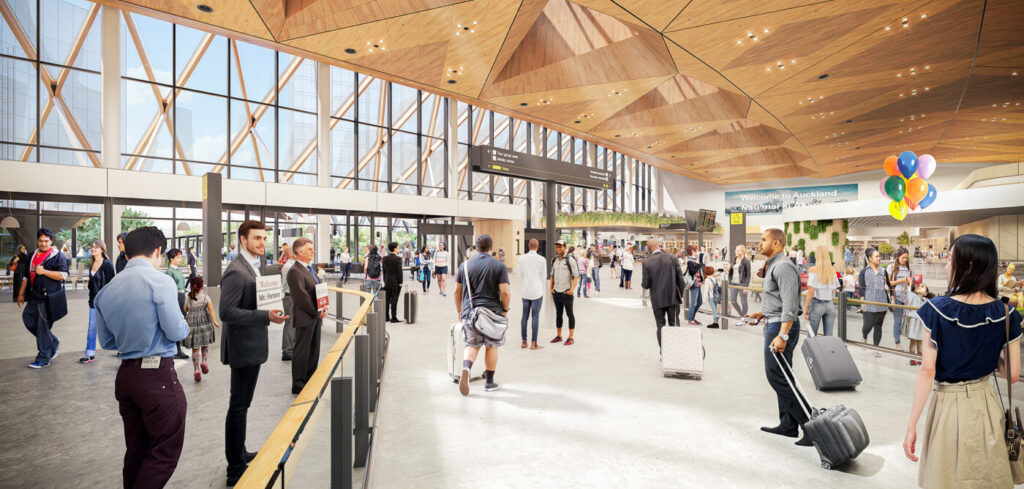At Auckland Airport, New Zealand, the groundwork is being laid for a new purpose-built domestic facility to be merged into the eastern end of the existing international terminal.
According to the airport, site preparation early next year will kick off the first stages of a project to move jet flights arriving and departing for major New Zealand towns and cities into a new domestic hub merged into the current international terminal.
“We haven’t wasted a day since the outbreak of Covid-19, using the time to plan ahead and develop a refreshed pathway for future infrastructure that is realistic, prioritizes the right projects and is carefully aligned with aviation’s recovery,” said airport chief executive Adrian Littlewood.
“The construction of a new domestic facility closely integrated with our international safe travel zone operations will provide a seamless journey between major New Zealand destinations and our global air connections. For Auckland-based travelers, a new transport hub with upgraded pedestrian, transport links, and car parking will offer a smooth connection into the terminal building.”
Auckland Airport had advanced design work and signed construction contracts for a new domestic jet hub prior to the outbreak of Covid-19, featuring a new pier, apron and airside dwell, and food and beverage and retail spaces. It was one of the major infrastructure projects that were cancelled or deferred when the pandemic arrived.
Now, the first stage of the project is expected to get underway in early 2022, relocating important back-of-house infrastructure that lies in the footprint of the planned domestic hub.
“We previously had around 30,000 people arriving and departing at the international terminal every day. That’s fallen by around 97% to just a thousand or so a day currently. We’re taking advantage of the downturn where we can, demolishing and relocating operations and services to clear the domestic hub site, while bringing forward upgrades of core utilities critical to the functioning of the airport while passenger numbers are low. The low-traffic environment has also allowed us to re-look at and refine the original design and construction phasing to arrive at what we think will be an even better end result,” explained Littlewood.
The first stage of work scheduled for early 2022 and costing around NZ$30m (US$21m) will include:
- Demolishing and relocating the legacy eastern baggage hall, livestock holding area and waste disposal facilities;
- Relocating key utilities, including the international terminal power center and truck dock;
- Relocating the operations control center and emergency operations center; and
- Carrying out ground, services, and technical investigations.
Beyond demolition and enabling works the next major phase of development for the NZ$1bn+ (US$705.6m) domestic hub would, says the airport operator, be determined by a range of factors including the speed of aviation’s recovery.
The new domestic operation will be around three times the size of the current domestic terminal, when accounting for shared check-in (kiosk-based) for both international and domestic travelers. It will include large, light-filled dwell spaces with views across the airfield to the Manukau Harbour and expanded contiguous security screening.
A new transportation hub is also planned for outside the existing international terminal, providing a new covered pick-up/drop-off area, valet services and covered parking lots connected to the terminal by an enclosed pedestrian bridge. The transportation hub will accommodate both commercial and public transportation options for travelers.
The domestic hub will initially accommodate jet operations (aircraft flying to the main centers). Regional services would continue operating from the existing domestic terminal building and move across to the main terminal building later.
Prior to the outbreak of Covid-19, Auckland Airport had begun delivering on over NZ$2bn (US$1.4bn) of core aeronautical infrastructure projects with all eight “anchor projects” in either construction or feasibility and design stages.
As part of its revised goals, the airport plans to advance four anchor projects as part of its wider infrastructure program:
- NZ$160m (US$112.8m) in upgrades to roading and new transit system (Northern Network and SH20B improvements);
- NZ$1bn+ new domestic hub;
- Approximately NZ$200m (US$140m) transportation hub;
- Around NZ$75m (US$53m) in ongoing upgrades to the existing domestic terminal.
The projects that remain on hold are:
- Expanded international airfield and taxiway capacity;
- New cargo precinct;
- New international arrivals area; and
- Second runway.
[ends]


